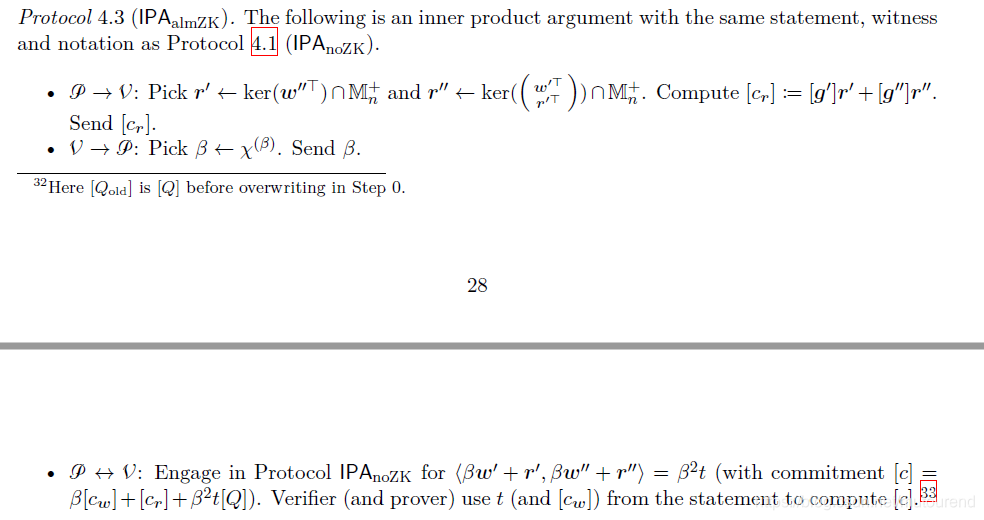接之前博客qesa——零知识证明,需要trusted setup。
- 注意:无论是在qesa还是bulletproofs中,inner-product的challenge x向量和y向量的选择应满足如下特征:
2019年论文《Efficient zero-knowledge arguments in the discrete log setting,revisited (Full version)》第四章:
在protocol 3.9基础上,以
为例(
取2值可最小化交互信息量),
可转化为以点积(inner product)方式表示为:
。
根据protocol 3.9第二步,prover仅需给verifier传递
。

时,
,如需证明
,在第三步和第四步,引入了challeng
,改为证明:
。
1. Bulletproofs的Inner-product argument
2017年论文Bulletproofs: Short Proofs for Confidential Transactions and More第三章,分别取的是 。
qesa中的Protocol 4.1(除了其中的Step 0),与Bulletproofs中的Protocol 1(论文中challenge固定为
)完全相同。具体的代码实现可参见https://github.com/crate-crypto/qesa/blob/master/src/ipa/no_zk.rs中的实现。其中challenge x向量和y向量的取值分别为:
。

2. qesa的zero-knowledge Inner product argument (IPA)
qesa在bulletproofs IPA(inner product argument)的基础上引入了zero-knowledge。引入的方式为由原来的证明:
改为证明(借助kernel特征):

的获取方式可参考https://github.com/crate-crypto/qesa/blob/master/src/ipa/gramschmidt.rs中代码:
//1. Compute r' and r''
//
let r_prime = sample_gram_schmidt(&b_Vec);
let r_prime_prime = sample_gram_schmidt_twice(&a_Vec, &r_prime);
/// Samples a random matrix and returns a random vector
/// which is orthogonal to `a`
pub fn sample_gram_schmidt(a: &[Scalar]) -> Vec<Scalar> {
let sampled_matrix = sample_m_n_plus(a.len());
orth(a, &sampled_matrix)
}
/// Samples a random matrix and returns a random vector
/// which is orthogonal to `a` and to `b`
/// XXX: We can make a better API for this and naming convention
/// XXX: Naming it sample_gram_schmidt twice could imply that we sample twice
pub fn sample_gram_schmidt_twice(a: &[Scalar], b: &[Scalar]) -> Vec<Scalar> {
let orth_a_b = orth(a, &b);
let orth_a_sample = sample_gram_schmidt(a);
orth(&orth_a_b, &orth_a_sample)
}
fn sample_m_n_plus(n: usize) -> Vec<Scalar> {
let mut r: Vec<Scalar> = vec![Scalar::zero(); n];
let mut rng = rand::thread_rng();
r[0] = Scalar::random(&mut rng);
r[1] = Scalar::random(&mut rng);
let mut i = 4;
while i <= n {
r[i / 2] = Scalar::random(&mut rng);
r[i / 2 + 1] = Scalar::random(&mut rng);
i = i * 2
}
r[n - 2] = Scalar::random(&mut rng);
r[n - 1] = Scalar::random(&mut rng);
assert_eq!(n, r.len());
r
}
/// Returns an vector that is orthogonal to `a`
/// Formally, this function projects `b` orthogonally onto the
/// line spanned by `a`
pub fn orth(a: &[Scalar], b: &[Scalar]) -> Vec<Scalar> {
let aa: Scalar = inner_product(&a, &a);
let ab: Scalar = inner_product(&a, &b);
assert_ne!(Scalar::zero(), ab);
let x: Scalar = ab * aa.invert();
let ax: Vec<Scalar> = a.iter().map(|k| k * x).collect();
let b_minus_ax = b.iter().zip(ax.iter()).map(|(r, s)| r - s).collect();
b_minus_ax
}
详细的实现过程见qesa论文 protocol 4.3.

参考资料:
[1] 2019年论文《Efficient zero-knowledge arguments in the discrete log setting,revisited (Full version)》
[2] https://github.com/topics/zero-knowledge?o=desc&s=stars
[3] 博客Inner Product点积的零知识证明
[4] 2017年论文Bulletproofs: Short Proofs for Confidential Transactions and More
